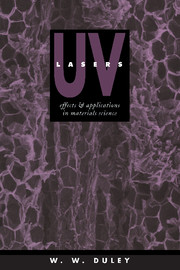Book contents
- Frontmatter
- Contents
- Preface
- Acknowledgments
- 1 Short wavelength lasers
- 2 Optical properties of materials at UV wavelengths
- 3 Photochemical and photothermal effects
- 4 Interaction of UV laser radiation with metals
- 5 Interaction of UV radiation with organic polymers
- 6 Interactions and material removal in inorganic insulators
- 7 UV laser preparation and etching of superconductors
- 8 Interactions and effects in semiconductors
- 9 Laser deposition
- Index
3 - Photochemical and photothermal effects
Published online by Cambridge University Press: 16 November 2009
- Frontmatter
- Contents
- Preface
- Acknowledgments
- 1 Short wavelength lasers
- 2 Optical properties of materials at UV wavelengths
- 3 Photochemical and photothermal effects
- 4 Interaction of UV laser radiation with metals
- 5 Interaction of UV radiation with organic polymers
- 6 Interactions and material removal in inorganic insulators
- 7 UV laser preparation and etching of superconductors
- 8 Interactions and effects in semiconductors
- 9 Laser deposition
- Index
Summary
INTRODUCTION
Ultraviolet laser sources can initiate both photochemical and photothermal effects in condensed media. The relative importance of these two effects depends on a variety of factors including laser wavelength, pulse duration, intensity and the photochemical/photothermal response of the irradiated material. In addition, exposure to UV laser radiation can result in radiation conditioning or hardening, such that the response of the medium to subsequent irradiation may be quite different from its initial response.
This chapter explores some of the fundamental limitations of materials processing with lasers as they relate to the physical and chemical response of the irradiated medium. Some general constraints on the relative rate of ablation in photochemical and photothermal regimes are also discussed. The question of radiation resistance is shown to exhibit both geometrical and physico-chemical characteristics.
FUNDAMENTAL LIMITATIONS IN LASER MATERIALS PROCESSING
At the intensities customarily used in laser processing of materials, the irradiated sample is exposed to an intense radiative environment that is generally far from the equilibrium state of the ambient medium. The thermal or physical change in the irradiated medium is then driven by an attempt to approach a new equilibrium in the applied radiation field. In general, even at intensities that may be as large as 108W cm–2, the response function of an irradiated medium is usually described using classical heat transfer theory. There are, however, implicit limitations to the validity of this theory as well as assumptions implied by the adoption of this description of the thermal response that may be relevant at high incident laser intensities or short pulse durations (Harrington 1967, Duley 1976).
- Type
- Chapter
- Information
- UV LasersEffects and Applications in Materials Science, pp. 78 - 97Publisher: Cambridge University PressPrint publication year: 1996
- 2
- Cited by



